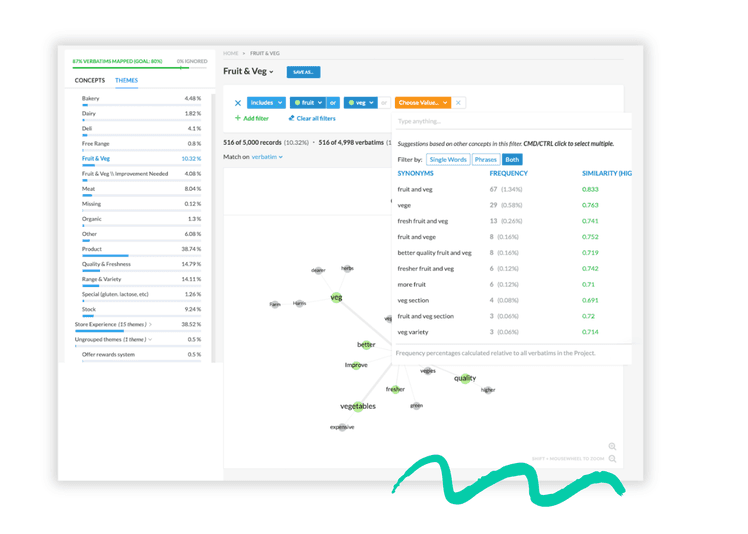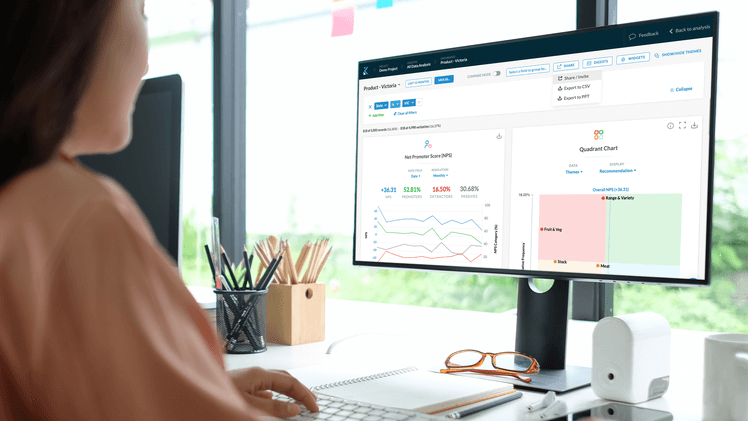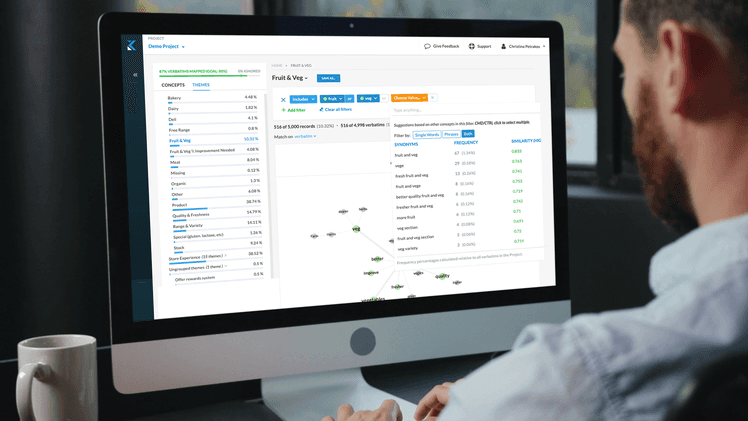When it comes to doing customer research, gathering feedback is only half the battle.
The true value lies in understanding that feedback. And for qualitative data, thematic analysis is a major key to unlocking meaningful insights. Thematic analysis is one of the leading qualitative research methods and is an essential tool for identifying patterns and themes within your qualitative data.
Whether you’re analyzing open-ended survey responses, customer support chats, or social media conversations, thematic analysis helps you uncover patterns that are essential for shaping your customer experience strategies.
Why does this matter? Research shows that survey response rates are on the decline – it’s more critical than ever to extract as much value as possible from the qualitative data you do have.
In this article, we’ll walk through a step-by-step guide for doing thematic analysis in qualitative research. So you can get the most out of your customer data and transform it into actionable insights for your business.
Why Use Thematic Analysis in Qualitative Customer Research?
Thematic analysis is one of the most effective methods for interpreting qualitative customer feedback and can play a critical role in your customer insights strategy. But what exactly is thematic analysis? At its core, it’s a process that involves identifying patterns, themes, or trends within qualitative data, allowing you to draw meaningful insights that quantitative data alone can’t provide.
In customer research, qualitative data—like open-ended survey responses, customer support conversations, or even social media comments—reveals the “why” behind customer behaviors. While quantitative metrics such as NPS or CSAT are valuable, they only scratch the surface of how your customers feel. Qualitative researchers play a crucial role in understanding this subjective data, helping businesses make informed decisions based on customer insights.
“Thematic analysis helps you dive deeper into the emotional drivers, pain points, and hidden opportunities within your customer base.”
Without a robust approach to qualitative analysis, organizations often leave valuable insights on the table. Imagine the cost of missing out on data that could guide new product features, improve customer service experiences, or reshape your marketing strategy. This is why thematic analysis is essential: it gives structure to your unstructured data, ensuring you maximize every piece of feedback. Additionally, integrating quantitative research with qualitative methods provides a comprehensive understanding of customer feedback, combining numerical scores with in-depth context.
5 Steps for Thematic Analysis in Qualitative Research
Now that you understand the importance of thematic analysis in customer research, let’s break down the steps to get the most out of your qualitative data through a structured thematic analysis process.
By following these five steps, you’ll be able to turn messy, unstructured feedback into clear, actionable insights that fuel your customer experience strategy.

1. Familiarize Yourself with the Data
Before diving into analysis, it's crucial to thoroughly understand your data set. This means reviewing your customer feedback—whether it’s from open-ended survey responses, customer service transcripts, or social media comments—and immersing yourself in what your customers are saying.
At this stage, don’t worry about categorizing or coding anything. Your goal is to get a feel for the data, identify any initial patterns, and become aware of recurring themes. Pay attention to the language your customers use. Are they frustrated with a specific product feature? Do they rave about your customer support team? These early observations will guide you later in the analysis process.
Why this step matters: Without a deep understanding of your qualitative data, you risk missing key insights. Without proper context, it's possible to be hasty in generating codes, for example, and bucketing your data in the wrong places. Familiarization allows you to approach the analysis process with context, helping you and your team avoid surface-level conclusions.

2. Generate Initial Codes for Qualitative Data
Once you've reviewed your data, it's time to start coding. Coding involves labeling segments of your data with keywords or phrases that summarize the essence of what’s being said. These codes will eventually lead you to broader themes.
Here, you can take a manual approach—where you read through the data and assign codes—or leverage software tools to make this process faster.
Kapiche for example, offers an AI-powered auto-theming capability, simplifying the coding process significantly. With auto-theming, Kapiche automatically categorizes and analyzes your qualitative data, generating summaries, identifying trends, and providing insightful explanations of the patterns that emerge.

Why this step matters: Coding organizes your data, making it easier to detect recurring themes and trends. If done manually, you can benefit from all the context that comes with spending more time in the data. However, leveraging tools like Kapiche can accelerate this process, while keeping context layers intact as you make insights accessible to your entire team.

3. Search for Themes
Once your data is coded, it's time to group similar codes together to form themes. Themes are broader patterns that give you a higher-level understanding of the feedback you’ve collected. For example, if multiple codes relate to "slow service," you might identify "speed of service" as a recurring theme.
Kapiche’s platform allows you to quickly visualize and explore themes using AI-powered capabilities. If you choose to do a blend of manual and automated thematic analysis, Kapiche surfaces themes that you might have missed manually, providing an extra layer of insights. Automatic summaries can also highlight the importance of specific themes, providing further context on how they impact your business.
Why this step matters: Themes provide structure to your analysis, and allow you to draw more meaningful conclusions from your data. Without achieving proper theme identification, your analysis will feel fragmented, making it difficult to derive actionable insights.

4. Review and Refine Themes
Now that you’ve identified your themes, it’s time to review them. Do they make sense? Are they too broad or too narrow? In this step, you’re ensuring that your themes accurately reflect the data, while also checking if some themes can be merged or need further refinement.
This is also an opportunity to return to the original data and verify whether the themes you've chosen hold up against the actual feedback. It’s a quality control step that guarantees your analysis stays true to your data set.
Why this step matters: Reviewing and refining your themes helps make sure your insights are accurate and not based on biased assumptions. Skipping this step can lead to overgeneralizations, or in the case of multiple team members analyzing and reporting on data, incongruent interpretations that confuse the true sentiment of your customers.

5. Present Findings and Take Action
The final step is to present your findings in a way that drives action within your organization. This could be in the form of a report, a presentation, or even an interactive dashboard. Your job is to make sure the insights are clearly communicated and understood by key stakeholders, from the product team to marketing, customer support, and beyond.
A typical thematic analysis report includes an introduction, methodology, results and findings, and a conclusion. This structure ensures a coherent narrative supported by quotes and interpretive analysis, allowing for transparent reporting and assessment of the rigor of the analysis.
A number of Kapiche’s features, including “at-a-glance” summaries, custom reports and email digests, make this step easy by providing concise summaries and actionable insights from your themes. This allows you to share the “what” and more importantly, the “why” of your findings with confidence, ensuring your insights translate into meaningful business decisions.

Why this step matters: Insights are only valuable if they’re acted upon. Presenting your findings clearly and persuasively ensures your customer insights have a real impact on business strategies.
Pitfalls to Avoid in Thematic Analysis
Even though thematic analysis can be incredibly powerful, there are a few common mistakes that can derail the process, leaving your valuable customer insights untapped.
Here are some key pitfalls to watch out for and tips on how to avoid them:
1. Overlooking data that doesn’t fit preconceived notions
When analyzing qualitative data, it’s tempting to focus on the feedback that aligns with your expectations. This bias can prevent you from uncovering new, valuable insights.
Always approach your data with an open mind, and let the themes emerge naturally, even if they’re surprising or don’t fit into your current assumptions.
2. Not having a clear research question
Without a clear goal or research question guiding the analysis, it’s easy to get lost in the data. This can lead to vague or irrelevant themes that don’t drive actionable insights.
Aim to start with a focused question that will help guide your thematic analysis toward meaningful results. For example, "What are the most common pain points in the customer support experience?" gives you direction and focus.

3. Inconsistent coding
The coding process—identifying and categorizing themes—needs to be consistent. Inconsistent coding can result in inaccurate or misleading conclusions. If multiple people are working on the analysis, ensure you’re all using the same guidelines and definitions.
Using a robust platform like Kapiche with its AI-powered auto-theming feature helps streamline this process, ensuring consistency across the board.
4. Trying to force all data into themes
Not every piece of data will fit neatly into a theme. Sometimes, there are outliers and anomalies that don’t align with the dominant themes you’re identifying. That’s okay!
Forcing every piece of data into a category can dilute the significance of your findings. Instead, recognize when certain data points stand alone and analyze them separately.
5. Ignoring the context of the data
Qualitative data is rich in context—whether it’s social media comments, customer interviews, or support logs. Failing to consider the source and context of the feedback can result in surface-level conclusions.
Remember to consider the background behind the feedback when interpreting themes to capture the full scope of the customer’s experience.
By staying aware of these pitfalls, you can ensure that your thematic analysis is accurate, thorough, and leads to actionable insights that positively impact your customer experience strategy.
Thematic Analysis Software
Thematic analysis software is a valuable tool that can help researchers streamline and organize theanalysis process. Software can assist with anything from coding, to theme identification, and data visualization, making it easier to identify patterns and themes in the data.
At Kapiche, we streamline this process with AI-powered auto-theming capabilities. Our platform helps you analyze and interpret customer feedback efficiently, enabling you to uncover valuable insights with ease.
Ready to see how Kapiche can revolutionize your thematic analysis and boost your customer insights? Click the link below to book an on-demand demo and explore how our tools can enhance your qualitative research efforts: Watch an On-Demand Demo of Kapiche Now
FAQs
What is thematic analysis in qualitative research?
Thematic analysis is a method used to analyze qualitative data by identifying, analyzing, and reporting patterns or themes within a dataset. In the context of customer insights, it allows you to discover key trends and themes in customer feedback, uncovering the Voice of the Customer (VoC). By organizing this data into actionable insights, thematic analysis helps teams understand customer needs, preferences, and pain points at a deep level.
What are the 5 steps of thematic analysis?
Familiarizing yourself with the data: Immerse yourself in the qualitative data to fully understand it.
Coding: Generate initial codes to organize and group data into meaningful categories.
Identifying themes: Review your codes and start to group them into potential themes.
Reviewing themes: Refine the themes to ensure they accurately reflect the data.
Presenting findings: Finalize the themes and present them in a clear, concise way to drive action.







